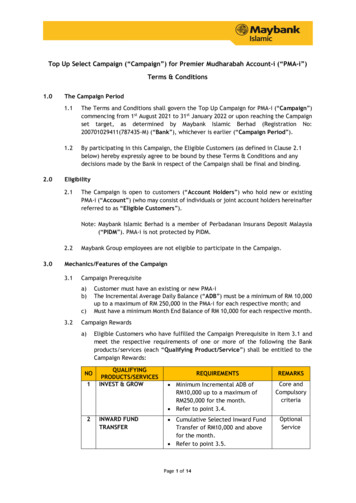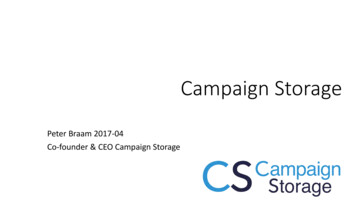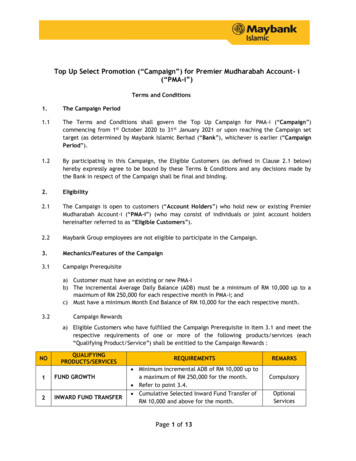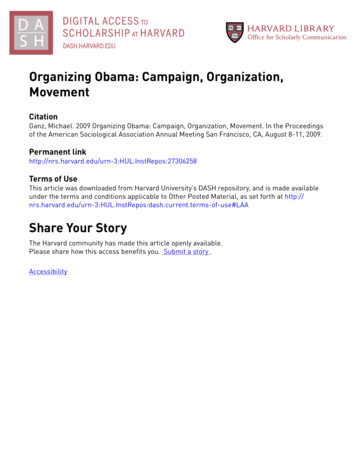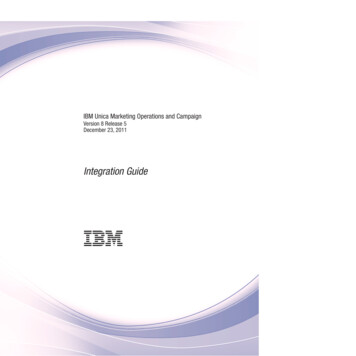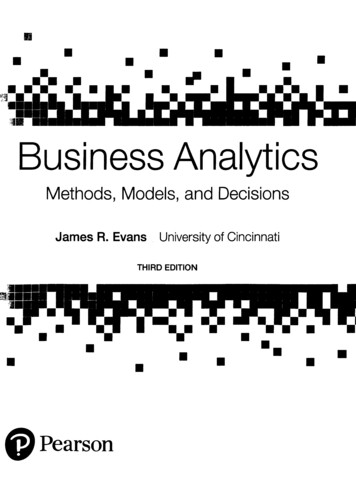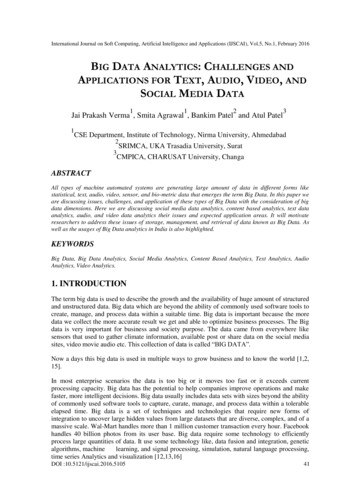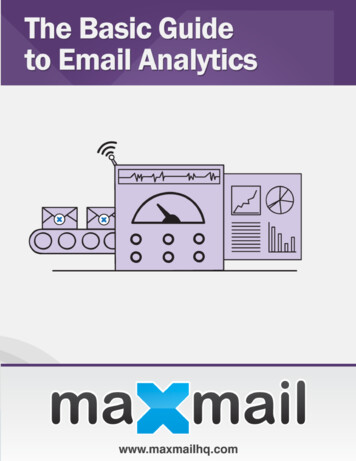
Transcription
Basic Guide to Campaign Analytics 1
Understanding CampaignAnalyticsThis guide was written for people new to email marketing who want to learn about each of thecampaign analytic types and what good email tracking software should be capturing.One of the most valuable aspects of using email to talk to your customers is that thesecampaigns are highly measurable . This means that marketers can see what is working, whatisn’t and also who is responding to a given message.Businesses need to better understand how to set goals and then analyze their campaigns, so thatthey can leverage the results to drive sales and retain customers. Ignoring the wealth ofinformation that you can get from closely watching campaign stats is a shameful waste, soplease, get in there and fill your boots!Campaign Analytics Terms and DefinitionsCampaign Analytics are statistics relating to a marketing campaign. In email marketing, these aretypically divided into the following five groups. Open/ unique open rates Delivery/ bounce rates Click through/ unique click rates Unsubscribe rates Conversion RatesBasic Guide to Campaign Analytics 2
Open Rates:Refer to the number of emails that were opened out of the total number sent in a campaign.(Generally expressed as a percentage)There are a few catches to this statistic and it is important to understand how the emailmarketing platform used measures what “open” means. Some count open as just beingdelivered, whereas Maxmail counts how many times the emails have actually been opened.The most useful open statistic is unique opens – which refers to how many emails have beenopened at least once – not factoring in multiple opens or forwards.WARNING: The results range widely from tool to tool. It’s really important to understand howeach of them works before comparing results.Delivery Rates:How many emails were delivered to the inbox.Like open rates, delivery rate statistics can paint a conflicting picture. Be careful when comparingtwo systems as some report an email as delivered when in fact it may have been deflected by aspam filter.Bounce rates:How many emails were returned to the sender as undeliverable. These are split into hardbounces and soft bounces.Hard BounceThis term is used to describe what happens when an email message is undeliverable because of apermanent, or non-temporary error (for example, if the given address no longer exists).Soft BounceAs you might imagine, a soft bounce occurs anytime there’s only a temporary problem deliveringBasic Guide to Campaign Analytics 3
an email. This typically happens if a recipient’s inbox is full, or if there’s a brief outage in emaildelivery.Click Through Rates:How many times links embedded in the email have been clicked on. Links can be attached to taglines, pictures or buttons.This is the most meaningful of the statistics because it shows you who is interested enough notjust to read your email, but also click through to the website to learn more. This is also the onlyemail marketing analytic that can be cross-referenced against your website statistics to validatethe accuracy of reporting.We suggest that you work on increasing the click through rate of your campaigns – it’sguaranteed to lead to a higher conversion rate!Unsubscribe Rates:How many subscribers opt-out of receiving emails from you. Unsubscribe rates can be measuredspecific to a campaign, over several campaigns over time or in relation to a list. The informationthat is received from this statistic is very valuable as it allows companies to immediately identifyissues that may exist between what is promised to a consumer and what is delivered by theemail campaign.Maxmail will give you an exportable list of who these people are and you can research why eachof them may have opted out of receiving your campaigns.Conversion Rates:How many qualified leads were generated from a campaign.Marketers can use this statistic to gauge how relevant the content was in relation to the targetedaudience. The key word here is targeted. If you haven’t segmented and personalised thecampaign enough it’s like using a scatter gun and your conversion rates are likely to be low.Conversion is generally that the target audience has responded to a call to action such as signingup online for a newsletter, opening an online account or making a purchaseBasic Guide to Campaign Analytics 4
Analyzing the DemographicsSegmentationCompanies that cater to a wide variety of demographics often segment the list of recipients of aparticular bulk email campaign to include only the portion of their customer base they’vedetermined the message will appeal to.As just mentioned, segmentation of your data base – which is about selecting a target audiencebased on what you know about each person will have a big effect on the success your campaignfor a couple of reasons.Firstly if you select the people in your optimum target market your campaign is likely to be highlyRELEVANT.Secondly, if you use what you know about your customers in the email copy to support yourpitch, it is highly PERSONALIZED. Both of these factors have proven to be crucial in the success ofemail campaigns. So, when comparing campaigns you will need to look closely at the similaritiesand differences between the demographics of your target audience in each campaign.Demographic s Gender Age Location Time of response Type of campaign Subscription retention (newsletter, etc) Average dollar received per email Referral ratesBasic Guide to Campaign Analytics 5Maxmail pulls together a report cardtype snapshot for every campaign sothat you can see at a glance how itperformed in comparison to theinitial expectations that you had forthat mailing.It’s not rocket science when it’sdisplayed graphically but it’s rocketfuel for your marketing campaigns!
Add to this list ANYTHING else that allows you to personalize your campaign such as shoe sizeor favorite gum flavor.Basic Analytics Your Email Tracking Software Should HaveFrom a minimalistic standpoint, any email tracking software used for marketing purposes shouldbe able to give data about: The time and date your recipient has opened your messageThe number of times your email has been readAmount of time your recipient spent reading the messageClicksOf course, for real data driven results your email tracking software should also be able to tellyou: Your recipient's locationIf any links embedded in your email have been clickedThe number of times your message has been forwardedThe software used to view the email e.g. Outlook, iPhoneBasic Guide to Campaign Analytics 6
information that you can get from closely watching campaign stats is a shameful waste, so please, get in there and fill your boots! Campaign Analytics Terms and Definitions Campaign Analytics are statistics relating to a marketing campaign. In email marketing, these are typically divided into the following five groups. Open/ unique open rates
